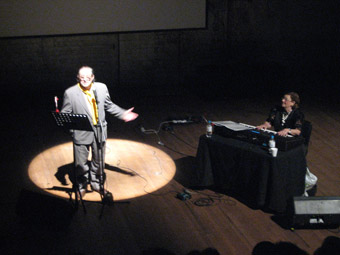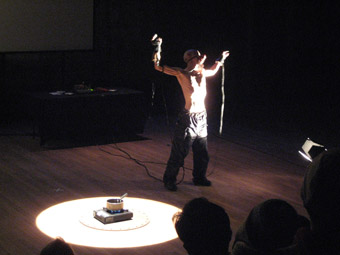sonic extremeties
gail priest embraces liquid architecture 8, sydney

Tony Mason-Cox and Ann Onymous, Liquid Architecture 8, Sydney
photo Shannon O’Neill
Tony Mason-Cox and Ann Onymous, Liquid Architecture 8, Sydney
OVER THE LAST THREE YEARS THE SYDNEY DIRECTORS OF LIQUID ARCHITECTURE, SHANNON O’NEILL AND BEN BYRNE, HAVE CONSISTENTLY DEMONSTRATED A BOLD AND DISTINCTIVE CURATORIAL APPROACH. EACH EVENING IS NOT ONLY CLEARLY CRAFTED TO EXPLORE A PARTICULAR ASPECT OR FETISH OF AUDIO EXPLORATION, BUT TO “DO SOMETHING TO YOU.” THE 2007 SYDNEY EVENT WAS THEIR MOST PROVOCATIVE YET.
surprise sounds
In a controversial move, the opening night seemed aimed at repelling audiences. The program notes claimed an exploration of popular music, but it felt more like a finger to the idea of scenes and acceptance: who is an outsider artist and who an insider; if it’s all about self-expression why are some people perceived as artists, some not? Daniel Green has a developing reputation for his performative video work, and he took a brave leap in presenting a live version of his excruciatingly daggy style, opening with “Tomorrow Belongs to Me” from Cabaret, in enthusiastic yet shaky baritone accompanied by occasional noise bursts on a toy guitar.
The audience was split between aghast and amused. Green continued with a remix travesty of “Maria” from West Side Story with glitched minidisk backing and finished off with a fiendish version of “Tell Me More” from Grease, played from a commercial DVD that supplies sing-a-long karaoke text, to which Green only sang “blah blah.” Knowing, and sometimes appreciating, Green’s work for video, I found this interesting not so much as sonic exploration but rather as a performance work, but to those in the dark it must have been indeed perplexing.
This disorientation worsened with the introduction of Tony Mason-Cox and his accompanist Ann Onymous. Mason-Cox is an insurance salesman who likes to pen a tune or two, particularly a dirty ditty, and enthusiastically sing them in his stumbling way. His first few limericks were amusing, but he seems to have written hundreds and the overload became tortuous, particularly for those with delicate political constitutions. What was most interesting was when Mason-Cox sang a serious song about his stepfather, his voice now frail and uncertain. The sentiment was genuinely moving—which made the audience distinctly uncomfortable. Was Mason-Cox’s inclusion in the program a challenge to sound art elitism or was he wilfully placed out of context? These conspicuously contentious questions charged the Sydney LA 8 opening evening. For those who hung on to the end, the glam rock mayhem of the band Winner was their clear reward.

Runzelstirn & Gurgelstock, Liquid Architecture 8, Sydney
photo Shannon O’Neill
Runzelstirn & Gurgelstock, Liquid Architecture 8, Sydney
actionist acts
In contrast, the second night promised to be truly terrifying with performances by actionist inspired artists Runzelstirn & Gurgelstock (one person actually, Rudolf Eb.er) and Dave Phillips from Switzerland and local artist Lucas Darklord (aka Thomas Knox Arnold). While Natasha Anderson on contrabass and garklein recorders with electronics might appear to be out of place in this industrial gothic line-up, her deft use of dynamics, texturing and attack gave her performance an intriguing brutality juxtaposed with fragility making her one of the most satisfying acts (conceptually and sonically) of the festival. Conversely, Lucas Darklord’s appearance—militaristic jacket with spiked shoulder pads and half blackened face—promised something more gruesome than we actually experienced, which turned out to be a polite set of dark and murky glitches shifting in and out of a timid apocalypse.
Dave Phillips was certainly disturbing for many with his video collage of human cruelty to animals, accompanied by poetically accusatory aphorisms and unrelenting noise floor. While the piece by Runzelstirn & Gurgelstock—involving a camp-stove with a pot of boiling vinegar, pig nose and a strap-on finger noise activator—looked ready to deliver on its threat of menace, the artist appeared gleeful in denying us any dramatic climax.
The evening ended with the video documentation of a performance by Runzelstirn & Gurgelstock involving a line-up of butoh inspired female performers drinking a variety of different coloured substances on cue to loud music and throwing up for a very long time. While outwardly a performance piece, its roots were in audio—by far the worst aspect of sitting through it was the sound of the women gagging, spitting and sticking their fingers further down their throats to prolong the action. As a very transparent “play” of manipulation and consensual subjugation, set very firmly within the extreme body zone of Japanese performance aesthetics, I was surprised by the agitated response to the piece as sexist by some in the audience. But then again not everyone has consensually subjugated themselves to a decade of performance art…
audio-visuality
The final evening concentrated on audiovisual explorations and did not seem planned to upset the audience, although excessive length did move it into the realm of endurance. The common theme, it seemed, was the re-emergence, for better or worse, of narrative in audiovisual works. Peter Newman has developed a distinctive style—intensely minimal visuals and dramatic bittersweet sounds—and he explored this further, pushing the sweet a little more than the bitter this time. Lloyd Barrett seems to use similar visual processing methods to Newman but opted for a (for some too) clear narrative using text panels to explicate his dream segments, creating a pithy short film feel to his set.
Kamusta (Chris Caines and Jessica Tyrrell) employed two screens—one a slowly setting sun, another a shifting melange of close-up street details—accompanied by a miminally developing soundscape and live voiceover by Caines. While all the elements were clear and considered, the piece as a whole did not develop beyond a kind of ambivalent ambience perhaps created by an unreconciled struggle with the figurative nature of text. Abject Leader introduced a performer to their 16mm film and audio set. There was potential in the beat poet flow of Jamie Hume’s offering, however the parodic gesture at character—safari suit, pith helmet and fake facial hair—felt underdeveloped and stylistically awkward, which along with some ornery projectors resulted in an overly long and difficultly paced set, although Joel Stern’s sounds maintained some momentum.
Cellule d’Intervention Metamkine, the team of French projection and sound artists came on at some time close to midnight for a 40-minute set when many of us in the audience had very little left to invest; however their dynamism was worth the wait. There is an orchestral quality, a Hitchcock-Herrmann grandeur to the work that is both perplexing and invigorating. The very hands-on manipulation of light is alchemical and magical, the structure of the set intriguing in its use of internal climactic steps and troughs. It felt like we were in the hands of dream masters…and when it was over we stumbled out shell-shocked and hazy, trying to remember our way home.
in situ
The festival also featured Terminal, installations by Jasper Streit, Natasha Anderson, Rik Rue and Wade Marynowksy, dotted around the CarriageWorks foyer. A potentially difficult venue due to sound bleed issues, the pieces were well-placed providing little islands of focus for audiences easily dissipated in the cavernous space. Marynowsky’s player piano automaton, Anderson’s abject testicular gloops and Streit’s minimal metal object provided as much visual as audio intrigue.
The curation of Liquid Architecture Sydney this year was wily and thought provoking, the experience of the whole festival being stronger and more satisfying perhaps than the individual performances. Despite the suspicion that programming of extreme acts might repel some audiences, the festival was very well attended with the final night at capacity. Sadly Shannon O’Neill and Ben Byrne have called it quits for Liquid Architecture. It cannot be said that they went quietly.
Liquid Architecture 8, Sydney directors Ben Byrne, Shannon O’Neill, national director Nat Bates; Performance Space at CarriageWorks, Sydney, June 28-30
RealTime issue #81 Oct-Nov 2007 pg. 46






